The Short, Strange Life of the First Friendly Robot
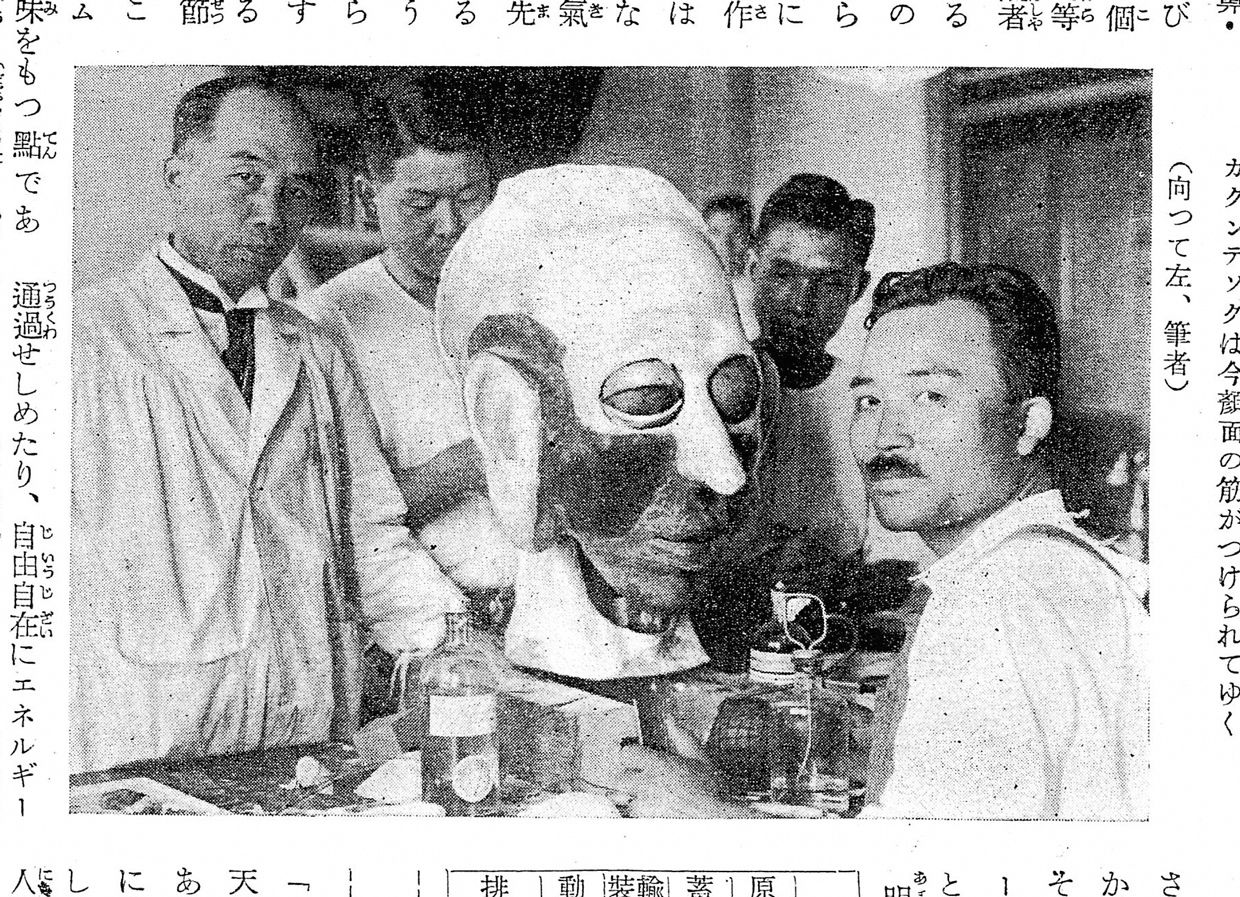 Photo: Kagaku Chishiki Face Time: Makoto Nishimura [left] and his team designed Gakutensoku's head so that it could express human affect.
Photo: Kagaku Chishiki Face Time: Makoto Nishimura [left] and his team designed Gakutensoku's head so that it could express human affect. In 1923, a play featuring artificial humans opened in Tokyo. Rossum's Universal Robots-or R.U.R., as it had become known-had premiered two years earlier in Prague and had already become a worldwide sensation. The play, written by Karel apek, describes the creation of enslaved synthetic humans, or robots-a term derived from robota, the Czech word for forced labor." apek's robots, originally made to serve their human masters, gained consciousness and rebelled, soon killing all humans on Earth. In the play's final scene, the robots reveal that they possess emotions just like we do, and the audience is left wondering whether they would also achieve the ability to reproduce-the only thing still separating robots from humans.
The play was deeply disturbing for Makoto Nishimura, a 40-year-old professor of marine biology at the Hokkaido Imperial University, in the northern Japanese city of Sapporo. As Nishimura would later explain in a newspaper article, he was troubled because the play convincingly portrayed the emergence of a perverse world in which humans become subordinate to artificial humans." A machine modeled on a human being but designed to work as a slave implies that the model itself (that is, we humans) are slaves, too, he argued. More concerning for Nishimura was that a struggle between humans and artificial humans was an aberration, something that went against nature.
Perhaps he wouldn't have been so upset by a work of fiction if he hadn't witnessed how this fantasy was already becoming a reality in his world. He was familiar with early European and Japanese automata-mechanical figures devised to exhibit autonomous behaviors. While some of these mechanical wonders displayed noble or creative abilities, like playing musical instruments, drawing, writing calligraphy, or shooting arrows, others carried out mindless tasks. The latter were the ones that troubled Nishimura.
By the end of the 19th century, the world had also seen a variety of steam men"-walking humanoids powered by internal steam engines (later models were powered by electric motors or gasoline engines) that appeared to pull carriages or floats. Many of these were developed in the United States. In the early 20th century, mechanical nurses, beauty queens, and policemen were introduced, and in his writings Nishimura also mentions mechanical receptionists, boat operators, and traffic cops. He may have seen some of these machines while he was living in New York City from 1916 to 1919 and pursuing a doctorate at Columbia University.
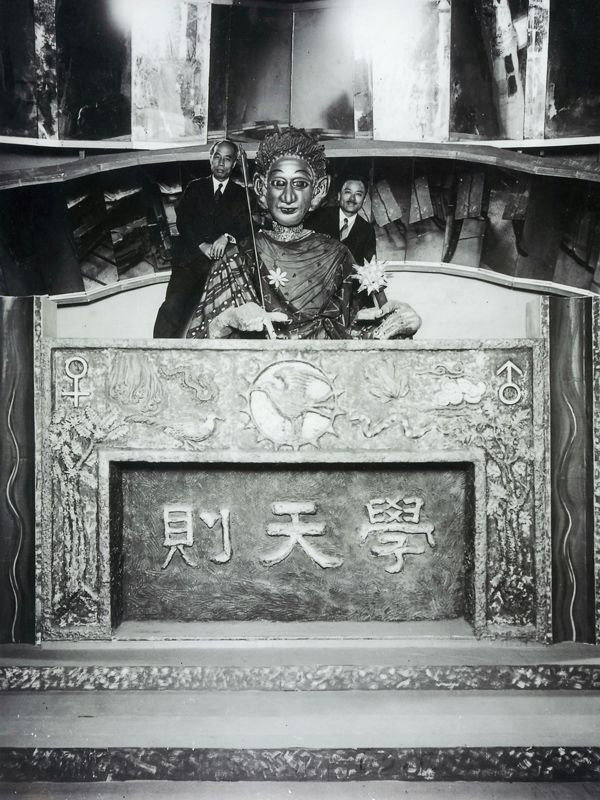 Photo: Hiroshi Matsuo/Osaka Science Museum Gentle Giant: Makoto Nishimura [to the left of Gakutensoku] and an assistant, Bji Nagao, pose with the robot, which was more than 3 meters tall, including its pedestal. (Photograph courtesy of Makoto Nishimura's grandson Hiroshi Matsuo. On permanent loan to the Osaka Science Museum.)
Photo: Hiroshi Matsuo/Osaka Science Museum Gentle Giant: Makoto Nishimura [to the left of Gakutensoku] and an assistant, Bji Nagao, pose with the robot, which was more than 3 meters tall, including its pedestal. (Photograph courtesy of Makoto Nishimura's grandson Hiroshi Matsuo. On permanent loan to the Osaka Science Museum.) From our perspective, those machines seem more like curiosities than working devices. But for Nishimura, their potential to perform useful labor was as convincing as today's new AI and robots are to us. As a scientist he had witnessed attempts to create artificial cells in the laboratory, which only reinforced his belief that artificial human beings would one day populate Earth. The question was, what kind of artificial humans would those be, and what kind of relationship would they have with biological humans?
In Nishimura's opinion, the character of artificial humans-or any technology, for that matter-was determined by the intentions of their creators. And the intent behind carriage-pulling, steam-powered humanoids was to create workers enslaved by their human masters. That, in Nishimura's mind, would inevitably lead to the formation of an R.U.R.-style exploited underclass that was bound to rebel.
Fearing a scenario that he described as humanity destroyed by the pinnacle of its creation," Nishimura decided to intervene, hoping to change the course of history. His solution was to create a different kind of artificial human, one that would celebrate nature and manifest humanity's loftiest ideals-a robot that was not a slave but a friend, and even an inspirational model, to people. In 1926, he resigned his professorship, moved to Osaka, and started building his ideal artificial human.
Nishimura's creation was a direct response to one particular machine: Westinghouse's Televox, which debuted in 1927. Televox was a clunky, vaguely primate-shaped being designed to connect telephone calls. It exemplified all that Nishimura had come to fear. The creation of such a slavelike artificial human was not just shortsighted but also contrary to what Nishimura, the scientist, conceived of as the laws of nature. It was an abomination.
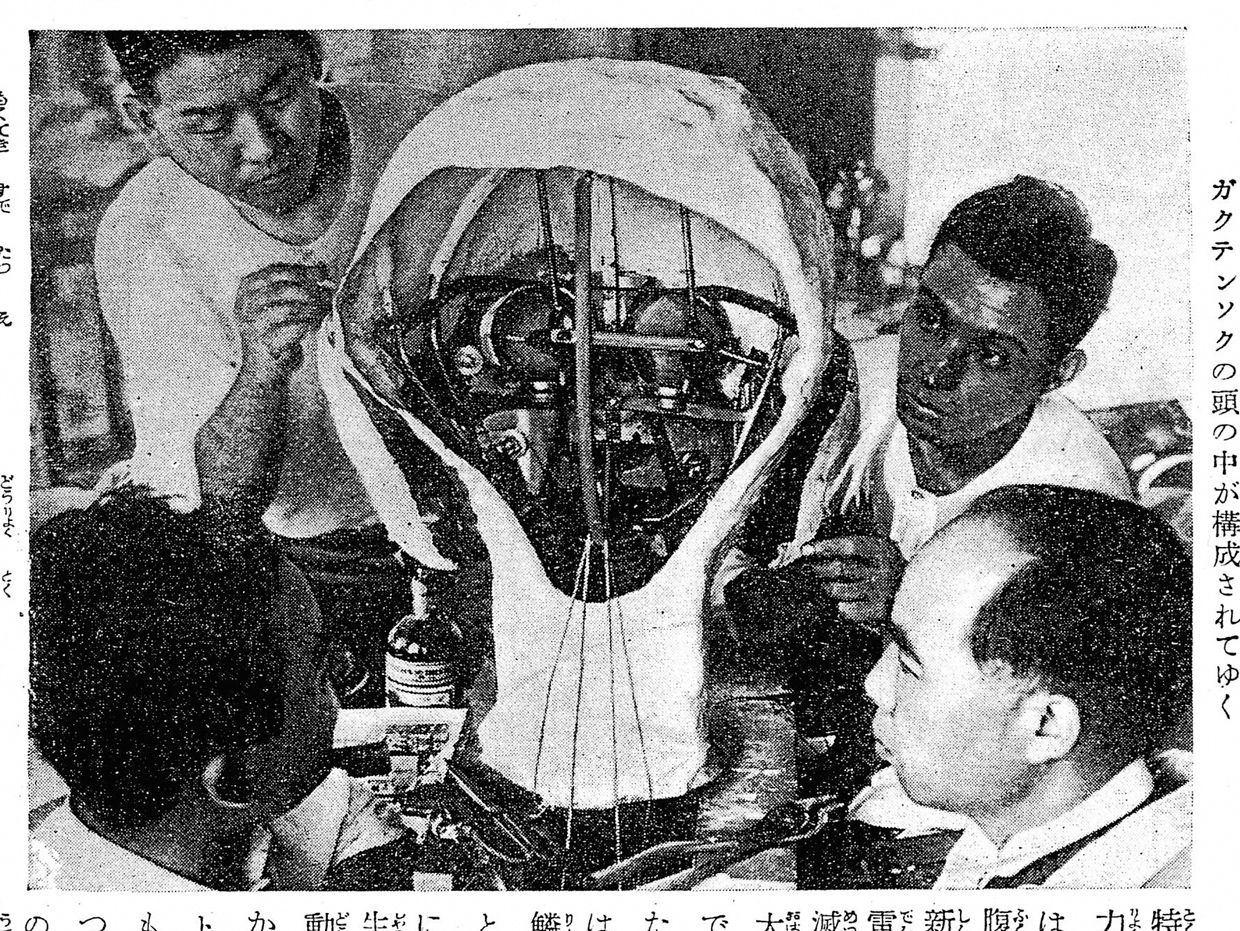 Photo: Kagaku Chishiki Minds and Machines: Makoto Nishimura [right] and his team work on the mechanism inside Gakutensoku's head. The mechanism allowed the robot to move its eyes, mouth, and neck.
Photo: Kagaku Chishiki Minds and Machines: Makoto Nishimura [right] and his team work on the mechanism inside Gakutensoku's head. The mechanism allowed the robot to move its eyes, mouth, and neck. A curious thing about Nishimura's decision to build a robot was that he wasn't an engineer and possessed no expertise in mechanical or electrical systems. He was a marine biologist with a Ph.D. in botany. When he first encountered apek's R.U.R., he was finishing an article on the cytology of marimo-aquatic moss balls endemic to the cold Lake Akan in northeast Hokkaido.
Yet it was precisely his background in biology that motivated Nishimura. An avid supporter of evolutionary theory, he was nevertheless skeptical of the idea of survival of the fittest" and loathed the rhetoric of social Darwinism, which pitted humans against one another. Instead he favored mutual aid" as the key driver of evolutionary change. He claimed that the core natural dynamic was collaboration, and that success by one individual (or one species) could be broadly beneficial.
Today, human advances are framed in terms of a conquest of nature,' " Nishimura wrote in Earth's Belly (Daichi no harawata), a 1931 book detailing his philosophy of nature. Rather than reflecting awe of the natural world, such triumph is more about kindling the struggle between humans." But look at human society, he urged: We cannot ignore the fact that humans achieved civilization through collaborative effort."
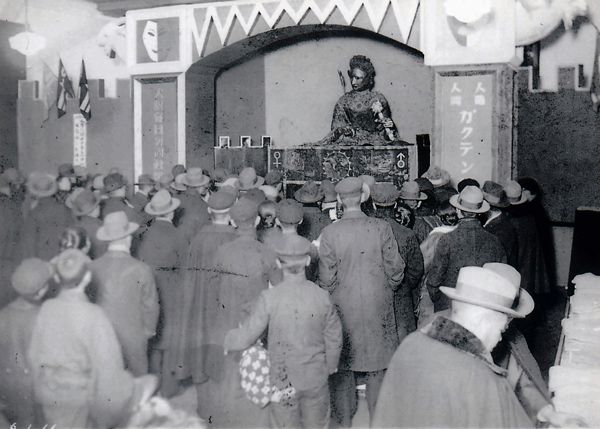
 Photos: Hiroshi Matsuo/Osaka Science Museum Crowd Pleaser: Gakutensoku attracted and awed visitors at exhibitions in Japan, Korea, and China. To support the robot's body, Makoto Nishimura [above, in hat and coat] and his team built a pedestal that displayed the robot's name on the front panel. (Photographs courtesy of Makoto Nishimura's grandson Hiroshi Matsuo. On permanent loan to the Osaka Science Museum.)
Photos: Hiroshi Matsuo/Osaka Science Museum Crowd Pleaser: Gakutensoku attracted and awed visitors at exhibitions in Japan, Korea, and China. To support the robot's body, Makoto Nishimura [above, in hat and coat] and his team built a pedestal that displayed the robot's name on the front panel. (Photographs courtesy of Makoto Nishimura's grandson Hiroshi Matsuo. On permanent loan to the Osaka Science Museum.) Nishimura's take on evolution and natural hierarchies had a profound effect on his views of artificial humans. This set him apart from European writers like Samuel Butler, H.G. Wells, and apek, who favored the survival of the fittest" model and postulated that the success of humanoid machines would spell doom for humankind. Nishimura insisted that flesh-and-blood humans could benefit from the evolution of artificial humans-if the artificial humans were designed to be inspirational models rather than slaves.
The artificial human Nishimura created was indeed meant to awe. Picture a giant seated on a gilded pedestal with its eyes closed, seemingly lost in thought. In its left hand, it holds an electric light with a crystal-shaped bulb, which it slowly lifts into the air. At the exact moment the lightbulb illuminates, the giant opens its eyes, as if having a realization. Seemingly pleased with its eureka moment, it smiles. Soon, it shifts its attention to a blank piece of paper lying in front of it and begins to write, eagerly recording its newfound insights.
Nishimura refused to call his creation a robot." Instead, he bestowed upon it the name Gakutensoku, which means learning from the rules of nature." He considered his creation the first member of a new species, whose raison d'etre was to inspire biological humans and facilitate human evolution by expanding our intellectual horizons. Nishimura rendered the word gakutensoku in katakana, a Japanese script also used for the scientific names of biological organisms. Nishimura envisioned future gakutensoku continuously evolving and becoming more complex.
Exactly how Gakutensoku operated has long intrigued historians and roboticists. Just a few years after its completion, the machine was lost under somewhat mysterious circumstances (more on that later). A few photos of the original design exist. But our only glimpse into its inner workings comes from an article Nishimura wrote in 1931. A talented writer, he often sacrificed technical detail for the sake of captivating prose and poetic expression.
Gakutensoku's chief mechanism was set in motion by an air compressor. Presumably the compressor was powered by electricity. The airflow was controlled by a rotating drum affixed with pegs. When the mechanism was activated, the pegs opened and closed the valves on numerous rubber pipes that sent air to particular parts of Gakutensoku's body and caused them to move. Similar to the mechanisms of classic automata, the arrangement of the pegs on the drum allowed for a rudimentary programming of the sequence of motions. Unlike in traditional automata, only the pegs and the drum were mechanical, while the rest of the mechanism was pneumatic.
Nishimura strove to create naturalness" in his machine. As he described in his article, he sought to transcend the mechanical look" and the noisiness and clumsiness of tin-can" bodies by eliminating as much metal as possible from Gakutensoku's frame. Only the robot's skeleton" was made of metal. For his creature's soft tissue, he used rubber, the elasticity of which made the movement much more natural, smooth, and without any sense of forced action." Additionally, unlike the American robots" that relied on steam, Gakutensoku was set in motion by compressed air, which Nishimura considered to be a more natural" power. He claimed that he arrived at the idea of using pneumatics after playing the shakuhachi (traditional Japanese bamboo flute) and experimenting with differences in the airflow. By varying the airflow and using different kinds of rubber with different elasticities, Nishimura was able to achieve complex, layered movement, which he described as if within a big wave there were a medium-size wave and inside it another tiny wave as well."
For Nishimura, the most important feature of Gakutensoku was its ability to express human affect. Again, this was the result of carefully modulating the compressed air flowing through the rubber tubes. Prolonged pressure put on the outer bottom corners of the eyes and to the side of the mouth resulted in a smile. Slight airflow applied to one side of the neck produced a contemplative head tilt. Pleased with the results, Nishimura wrote that compared to the American artificial humans, only ours has the ability to be expressive."
 Photo: Underwood Archives/Getty Images Clunky Contraption: In the late 1920s, Westinghouse unveiled the Televox, portraying it as a futuristic robot servant. The Televox exemplified the idea of robots as the slavelike machines that Makoto Nishimura had come to fear, motivating him to build Gakutensoku.
Photo: Underwood Archives/Getty Images Clunky Contraption: In the late 1920s, Westinghouse unveiled the Televox, portraying it as a futuristic robot servant. The Televox exemplified the idea of robots as the slavelike machines that Makoto Nishimura had come to fear, motivating him to build Gakutensoku. But when the flow of air to Gakutensoku's face was turned off, its facial expression suddenly and disturbingly collapsed. Nishimura and his team had to invent a device to allow the gradual release of air pressure, which they described as multiple wart-shaped convex parts aligned on one rotating axis.... Only when this modification was put in place did Gakutensoku finally stop looking like a mad man."
Nishimura emphasized the similarities between the structure of his artificial human and the anatomy of real human bodies. He claimed, for instance, that the compressed air that circulated inside Gakutensoku had a function similar to that of blood. Humans acquire energy by consuming food, and they distribute this energy through their circulatory system. Artificial humans, according to Nishimura, did something similar: They acquired electrical energy, then distributed this energy to different parts of their bodies by means of compressed air flowing in rubber tubes.
Nishimura's deep interest in biologically inspired design sometimes pushed him into philosophical semantics. Humans naturally get energy from their mother's womb, while artificial humans get it from humans," he wrote in Earth's Belly. So if humans are Nature's children, artificial humans are born by the power of the human hand and thus might be referred to as Nature's grandchildren."
Gakutensoku debuted in September 1928 at an exhibition in Kyoto celebrating the recently crowned Emperor Shwa (known in the West as Hirohito). Reflecting on the exhibition several years later in Earth's Belly, Nishimura reported that Gakutensoku awed the crowds. Despite its being over 3 meters tall, observers said that it looked more human than many expressionless humans." The following year, Gakutensoku was taken on tour and exhibited in Tokyo, Osaka, and Hiroshima, as well as in Korea and China, where the artificial human work[ed] from 6 a.m. to 8 p.m." greeting spectators. Newspapers in Japan, China, and Korea reported on the exhibition and published photographs of the gentle giant, so that even those who could not see it in person had an idea of what it looked like.
Then Gakutensoku disappeared.
Nishimura himself never explained what happened. In an interview published in 1991, the scientist's son K Nishimura said the automaton vanished en route to Germany during the 1930s. But K was only a child at the time of the disappearance. While I corroborated that Gakutensoku indeed traveled to Korea and China, I have found no record of its being sent to Germany. Even if the claim is true, we don't know where exactly it vanished or who took it.
Despite its mysterious disappearance, Gakutensoku left a legacy that continues to reverberate in Japanese pop culture and robotics. During World War II, Japanese animators produced propaganda-heavy cartoons in which robots were depicted as inspirational heroes that used their supreme powers to assist humans. In the 1950s, Osamu Tezuka's Astro Boy (Tetsuwan Atomu, or Mighty Atom") solidified the image of robots as emotionally sophisticated saviors driven by their empathy for other beings. I haven't seen any concrete evidence that Tezuka knew of Gakutensoku, but he grew up in the same suburb of Osaka where Nishimura lived and worked as a schoolteacher during the war.
Gakutensoku itself was featured as a character in a 1988 science-fiction movie titled Teito Monogatari (sometimes translated as Tokyo: The Last Megalopolis), in which the robot helps defeat the magical powers of a demonic villain. Nishimura, who died in 1956 at age 72, makes an appearance, played by his son K, who by then was one of Japan's best-known actors. The movie in turn inspired several books and TV shows exploring the origins of Japanese robots. In 1995 an asteroid spotted by Japanese astronomers was named 9786 Gakutensoku.
Then there's Gakutensoku's impact on Japanese robotics. Above all, many robot makers are guided by the underlying philosophy that machines are not in opposition to nature but rather part of it. Robots built in Japan from the 1970s on have a number of design characteristics reminiscent of those outlined by Nishimura-a preference for silent motion and the use of pneumatics; an emphasis on the textures of the robot's skin" and face"; and most important, an attentiveness to how people perceive and respond to a robot's humanoid features.
Since the '90s Japanese roboticists have channeled increasing efforts into cognitive robotics, exploring how humans think and behave in attempts to create likeable robot designs. Their aim is to build robots that not only perform tasks but also elicit positive emotional reactions in their users-robots that are friendly, in other words. It would be a stretch to say that Nishimura single-handedly shaped Japan's view of robotics, but the fact remains that few Japanese today fear R.U.R.-like scenarios of humanity being annihilated by their robotic overlords. As if fulfilling Nishimura's vision for a desirable relationship between humans and artificial humans, the common adage in Japan nowadays is that robots are friends."
Rebuilding the Giant Robot That Smiled There were no blueprints or detailed specifications, but Japanese researchers were able to create a faithful copy of GakutensokuIn 1992, Gakutensoku was featured in a promotional film titled Osaka-the Dynamic City. The movie portrayed the city as a futuristic technological hub, with Gakutensoku symbolizing Osaka's long history of innovation. For the purpose of the movie, producers commissioned a small-scale model. But even though the model looked like Gakutensoku, the inner mechanism was entirely redesigned with more modern technology, such as electric motors and digital controllers. After the movie was shot, the model was moved to the Osaka Science Museum.
In 2007, one of the museum's researchers, Nz Hasegawa, decided that having a fake" model didn't do justice to the technological legacy of Gakutensoku, and set about creating a more faithful, historically accurate reconstruction. The reconstruction process began in April 2007 and took a little over a year at a cost of 20 million yen (about US $200,000).
Hasegawa didn't have much to go on-just a few photos and articles by Nishimura and others. The photos were black-and-white, old, and somewhat blurry, and most were taken from the same angle. Moreover, looking at the different photos, Hasegawa realized that Nishimura must have made changes to the design over time, since the photos were not all consistent.
Nishimura's own articles offered only superficial details on Gakutensoku's construction and operation. For example, he described the height of Gakutensoku as 8 shaku"-a Japanese unit of length, equal to 30.3 centimeters (11.9 inches)-above the chest," which isn't very specific if you don't know the dimensions of the rest of the body. Hasegawa had to analyze a photo in which Nishimura appears next to Gakutensoku in order to arrive at his estimation of 3.2 meters (from the floor, including the pedestal). Then there was the question of Gakutensoku's original colors. Nishimura said that it was painted gold, but with only black-and-white photos available, Hasegawa didn't know, for example, whether the wreath of leaves that adorned its head was gold or green.
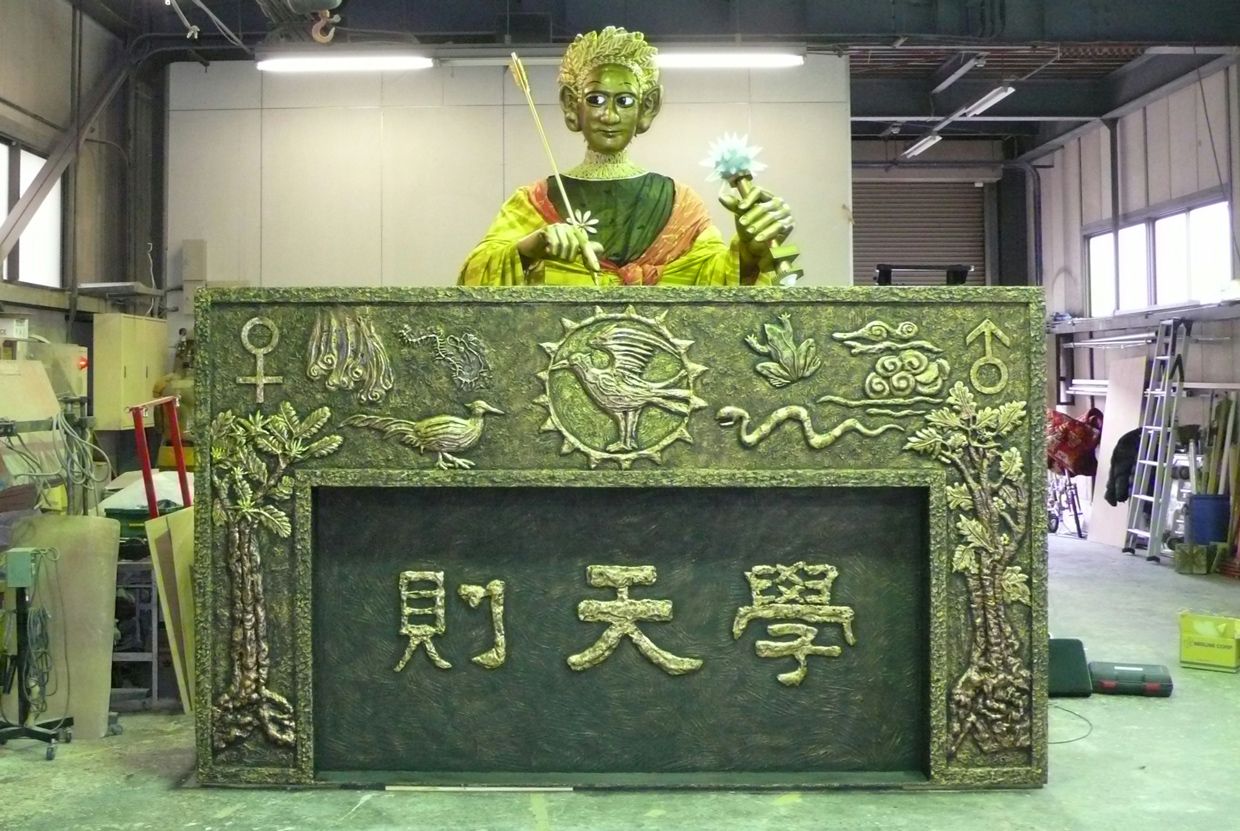
Hasegawa was able to re-create Gakutensoku's serene smile [above], produced by the flow of air into the corners of the eyes and eyelids. He also enabled Gakutensoku to move its head and neck, as described in various articles and documents, as well as lift its crystal inspiration light" and simulate a writing motion.

The reconstruction of Gakutensoku's inner mechanism [left], however, was tricky. Particularly challenging was the rotating drum designed to gradually increase and decrease the flow of air, to prevent Gakutensoku's facial expression from collapsing like a mad man," as Nishimura described it. Replicating this mechanism proved beyond the means of the Osaka Science Museum team. And so, although the motions of the 21st-century Gakutensoku are produced by compressed air, as in the original, the flow of air is controlled by a computer.
The reconstructed Gakutensoku still greets visitors to the Osaka Science Museum, reminding us of the genesis of the wondrous humanoid robots produced in Japan today, and echoing the motto Nishimura inscribed on the wall of his workshop: According to the origins and the evolution of living beings-from simple to complex." -Y.F.
Photos: Osaka Science Museum About the AuthorYulia Frumer is an associate professor of East Asian science in the department of history of science and technology at Johns Hopkins University, in Baltimore. She is currently researching the development of Japanese humanoid robotics, focusing on the historical roots of emotional responses to robots.